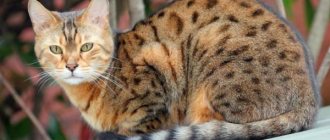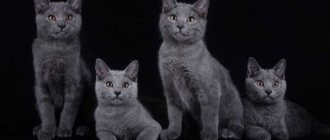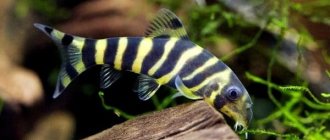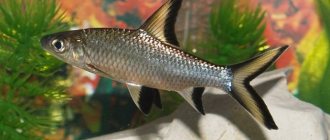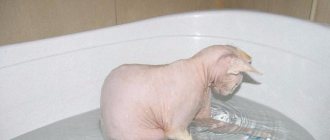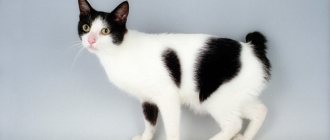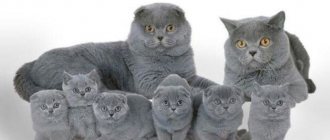History of the breed
There is a version that the first mention of these animals is found in the treatises of Siam and it was these animals that were brought to England in the nineteenth century under the guise of a chocolate Siamese. But the Siamese cat breed standard was formed in a different way and has undergone great changes.
Whether the Tonkinese cat is an “old” type of Siamese or not will never be known for certain, no matter how much felinologists argue.
In the sixties of the last century, Canadian breeder Margaret Conroy got a kitten by crossing Siamese and Burmese breeds and began to work on a new variety, naming it after the Vietnamese region of Tonkin. After the standard was written, many years of breeding work took place.
For fifteen years this cat was listed as a hybrid breed. True, this variety was originally called the “golden Siamese” because of its characteristic mink-like coat and color-point color.
The history of the name of the breed is romantic. In the USA there is a popular musical about the love of an American officer and a Tonkinese girl - the story takes place on the Pacific Islands. The moral of the story is the victory of high feeling over racial prejudice. The difficult fate of these cats, their long lack of recognition was the reason for this analogy. But the name “Tonkinese” was originally associated with the musical, in which the main character is a resident of Tonkin.
An Old Siamese cat named Wong Mau was brought to the United States of America by Dr. Joseph Thompson back in 1930. Her descendants became breeding animals - they were crossed with the Canadian line and the march of the Tonkinese cat began in America.
Today this breed is recognized by all felinological associations, but there are two standards: European and American.
History, character and description of the breed Tonkinese cat (Tonkinese)
The Tonkinese cat breed (Tonkinese) is a cross between the Burmese and Siamese cats, which is distinguished by its unique aquamarine eye color. Such cats were first mentioned in the writings of the 18th century. They say that at first the breed was not distinguished separately, but they preferred to classify them as Siamese. This animal has always lived near people: in cities and small settlements in Thailand. Over time, the unique breed spread from Thailand throughout the world, but everyone recognized it only as an ordinary Siamese cat. In the 1800s, veterinarian Joseph Thomson introduced several individuals to Britain. Many people bred them to catch mice in order to preserve crops. The ancestor of the breed is considered to be a Tonkinese cat named Wong-Meu. She became the first individual to be classified as a new breed and noted the unique characteristics inherent only to these cats. But the number of such cats was still minimal, so the world knew practically nothing about the Tonkinese. Later, Canadian breeders managed to obtain pure Tonkinese cats by cross-breeding Burmese and Siamese cats. A small circle of cat owners in Toronto have bred kittens with aquamarine eyes. The breeder had not previously mixed breeds, but the kittens amazed her with their beauty and unusual appearance. After delving into the topic in more detail, she learned about Wong-Meu and decided to find her descendants. Thus began the history of the Tonkinese cat pedigree.
Tonkinese cat photo:
Individual weight
The weight of Tonkinese males reaches 4-6 kg, and females - 3-4 kg.
Character
Tonkinese are distinguished by their kind and gentle character. According to reviews from owners, such pets always try to stay near their owner. In a large family, one person is not singled out and everyone is treated friendly. They jump on their hands and try to attract attention to themselves.
Care and care
Tonkinese dogs have little hair, so you don’t have to spend days brushing your pet or cleaning home carpets. Although shedding twice a year is common, any comb or glove for cats will help you cope with it. Other care features are no different from generally accepted rules: Weekly ear cleaning. This should be done with a soft cloth moistened in a light vinegar solution; Trimming nails every 2-3 weeks. Although many owners are against such a procedure, it should be carried out at least once a month. The fact is that at home the cat does not have time to grind off its claws and begins to involuntarily cling to everything around them: from carpeting to your expensive blouse. This brings discomfort and sometimes pain to pets;
Tonkinese cat or Tonkinese
Eye cleansing. Every morning, wipe the corners of your eyes with a damp, clean tissue. To prevent eye diseases, you can use a solution of warm green tea or chamomile infusion; Regular cleaning of the tray. Tonkinese prefer to relieve themselves in cleaned litter boxes and will feel extremely uncomfortable around dirty litter. Try not to feed Tonkinese cats "human" food, as this always leads to health problems. They can appear even after many years. Give your pet specialized food with a natural composition and dose the diet. Pour food into a bowl only at a clearly designated time, 2-3 times a day. Try not to follow the lead of a pet who begs for treats from every family member.
Photo of Tonkinese:
Features and breed standard
In terms of morphology, the Tonkinese cat resembles a Thai cat, but has a shorter and wider, slightly snub nose. This is an animal of medium size and constitution with a peculiar coat and a characteristic color point. Derived from crossing a Siamese and a Burmese, it is distinguished by its aquamarine eye color.
Description given to this breed by WCF:
- Head. Wedge-shaped, quite wide. The profile and cheekbones are quite softly outlined, the stop is small in size on the bridge of the nose.
- Neck. Medium size, strong and muscular.
- Eyes. Quite widely spaced, almond-shaped, but slightly rounded. The color must match the coat. From aquamarine to seawater color. Preferably clean and clear tones.
- Ears. The middle ones are wider at the base, tapering to slightly rounded tips. High standing, straight, not too wide apart. The fur on the ears is short, the ears appear translucent.
- Body. Medium build, muscular, with a toned stomach. Not elegant, but not massive either.
- Paws. Medium size, quite graceful, but strong, pads are round, but quite small.
- Tail. Medium size, proportional to the body, slightly tapering towards the tip.
- Wool. Short and shiny. Without undercoat, lying close to the body.
- Color. The main background is without a pattern, uniform, somewhat lighter on the inner parts of the body. The points—the “mask” on the face, the ears, paws, and tail—are darker, the transition from the main background to the points is smoothed out.
- Weight. Males are larger than females. From three to six kilograms.
- Knitting. Interbreeding only within the breed
- Flaws. Slight deformation of the tail, too heavy or graceful body, large snub nose.
Disqualifying signs:
- Yellow eye color
- White spots and medallions
- Tail break
- Aggressive behavior.
Colors
This is the only cat whose six, one of the main advantages of the breed, are compared to a mink. It was the delicate shades of color and its brilliant gloss - glitter - that gave the colors such a name.
There are five main colors of the Tonkinese cat. Their characteristics:
- Natural mink. The main background is light brown, the points are dark brown. The abdomen and inner surfaces of the paws are lighter than the rest of the body. The paw pads and nose are light to dark brown.
- Honey mink. The main background is cream with a golden-apricot tint. The points are red-brown of varying intensity. The paw pads and nose are the color of pink caramel.
- Champagne. The main background is light cream, the points are light brown. The paw pads and nose are a cinnamon shade of varying intensity.
- Blue mink. The main background is light gray with a bluish tint, the points are darker, smoky blue. Paw pads and nose - match the background color.
- Platinum mink. The main background is silver-gray, almost purple. Points are the same color, but more saturated with a purple gloss. The paw pads and nose are pink to gray with a lavender tint.
Some felinological systems combine honey and champagne mink into one category. In addition, the Siamese type of color is sometimes recognized - with a clear contrast from the background to the points, a solid Burmese color. The mink color is often classified as a mink color.
The formation of colors is completely completed no earlier than one and a half years. Therefore, in kittens and young individuals, lighter background colors and faint spots in the points are allowed.
Origin story
For the first time, descriptions of the Siamese cat are found in Siamese works created in the 14th century.
In the 18th century, the ancestors of the Tonkinese cat were brought to England, where they were called the “Chocolate Siamese.” The breeders became very interested in the animal's blue eyes and began to improve this trait.
And in the middle of the 20th century, these cats swam across the ocean and ended up in Canada, where one of the owners turned out to have a very shy cat who did not like Siamese cats at all.
But she liked the Burmese representative. As a result, the first kittens appeared with a light brown color and bright blue eyes.
For a long time, the breed was called “Golden Siamese,” until the breeder named the new cats after the Vietnamese city of Tonkin.
It is unknown why the owner of the new breed liked this name. It is believed that it was supposed to emphasize the elegance and grace of the animal.
Any photo of a Tonkinese cat shows the validity of this assumption.Character
The Tonkinese has taken the best from both breeds that created it. He is energetic and active, like a Siamese, but more silent, obedient and flexible, like a Burmese.
The soft and loyal pet always tries to be close to its owner. Strives to be picked up and loves to sleep with people.
Just like the Siamese, they love to talk, but at the same time they make quiet meowing sounds and are not so intrusive. They will feel sad when they are alone, so it is better to have a couple of these cats at home or, in addition to Tonkinesis, buy other pets.
They are smart, quickly learn to use the toilet and scratching post, and love to go for long walks with their owner on a leash, if you instill a love for a harness at an early age.
Character of the Tonkinese
Both Siamese and Burmese cats are very curious and playful. The Tonkinese borrowed their best character traits from these ancestors. These are very smart and lively cats, inquisitive, independent, but at the same time very devoted to their owners.
This is why they are considered wonderful companions. But at the same time, if you don’t raise kittens, they will grow into cats that will constantly follow their owner’s heels and even disturb him. Tonkinese cats are rarely stubborn, but it still may be that, despite the measures taken, the cat will still continue to stick to its line and follow its owner as if tied. In this case, you will have to put on a small theatrical performance. The fact is that Tonkinese are very observant and know how to notice facial expressions . When weaning your pet from any bad habit, you need to show him in every possible way how disappointed and upset the owner is. Since Tonkinese cats are very attached to their owner, one or two negative reactions are usually enough for them to stop misbehaving.
In general, Tonkinese cats do not like conflicts; they are very observant animals that have a good memory and even know how to find the weak points of their owners. But at the same time, psychologists recommend that children with autism have Tonkinese cats, since they know how to find an approach even to such kids.
Tonkinese love games. But if, when playing with the owner, they are quite content with the ball, then when alone they prefer more complex games, for example, with wind-up toys or overcoming an obstacle course.
Education, maintenance and care
Tonkinese is very easy to care for. The wool has no undercoat, shedding does not bother either the owner or the animal. It is enough to remove sparse changing hair from the pet’s body with wet hands.
There is also no need for combing. To massage the skin, this procedure, if the cat likes it, can be carried out once a week. But this must be done carefully, with a brush with a soft hair base, so as not to damage the delicate skin.
You should not leave your cat alone near an open window, especially on high floors. Playfulness is characteristic even of older animals. If you get carried away with hunting for insects, they can easily fall out.
Tokinesis has virtually no drawbacks; its second name, Golden Siamese, suits it extremely well.
Photo of a Tonkinese cat
Read here Singapore cat: history of origin, character and care of a rare breed (105 photos)
Help the site, share with friends 
Health and nutrition
Any cat can eat natural food. But in this case, it is very difficult to organize a balanced diet; it is necessary to use additional special supplements and vitamins. Therefore, after kittens are weaned from their mother, they are gradually transferred to super-premium dry ready-made food.
These are heat-loving animals; drafts should be avoided. Prolonged exposure to the sun is also useless - delicate fur can fade.
No characteristic diseases have been noted in this breed. As you age, gum problems may arise. To prevent them, you should be attentive to your pet and promptly contact a veterinarian.
To prevent diseases it is necessary:
- deworm the animal once every three months;
- regularly treat external parasites;
- Be vaccinated annually against rabies and all known feline infections.
Features of care
Tonkinese are clean animals, so they are easily and quickly toilet trained. Cat care does not include frequent bathing. This can negatively affect the condition of the coat.
The coat must be groomed with a brush. It is necessary to comb cats once a week with a new brush, thereby not only caring for the fur, but also giving a pleasant massage to the pet. In addition, this will reduce the entry of hair into your pet's stomach.
It is necessary to monitor the eyes and ears of Tonkinese dogs and clean them if necessary. The mouth should be checked once a week.
In addition, you need to purchase a scratching post for your cat. Nail trimming is carried out 1-2 times a week.
Nutrition
The Tonkinese cat eats twice a day. Or rather, she is ready to eat all day long and in large quantities. However, this leads to overeating and health problems. Therefore, switching to two meals a day in medium-sized portions is considered optimal.
Both homemade food and specialized food can be used as food. You should exclude fish and pork. When giving preference to homemade food, it is worth remembering that pets should receive vegetables, meat, and dairy products.
Health
Tonkinese cats are very healthy, active, and practically not susceptible to any serious diseases. The reason for this was that only healthy individuals that had passed the strictest selection were used during breeding.
But still, Tonkinese pets can be susceptible to gingivitis, strabismus, asthma, and with age they can experience intestinal problems.
Gingivitis can be prevented by a balanced diet; animals should mainly be fed dry food.
On average, with proper care and nutrition, Tonkinese live 13-16 years.
Mating and breeding
A Tonkinese cat can only be produced by a pair of Tonkinese cats. Only healthy individuals are allowed to mate; the optimal age for first mating is after one and a half years.
Cost of a kitten
Despite the wide distribution of the Siamese breed, it is almost impossible to find real Tonkinese in our country.
If you want to become the owner of just such a pet, you should contact one of the nurseries in the United States of America, Canada or Europe.
The cost of a pet-class kitten will not be less than five hundred dollars; animals of the breeding class (for breeding) and show classes will be sold at a price of eight hundred dollars and more.
